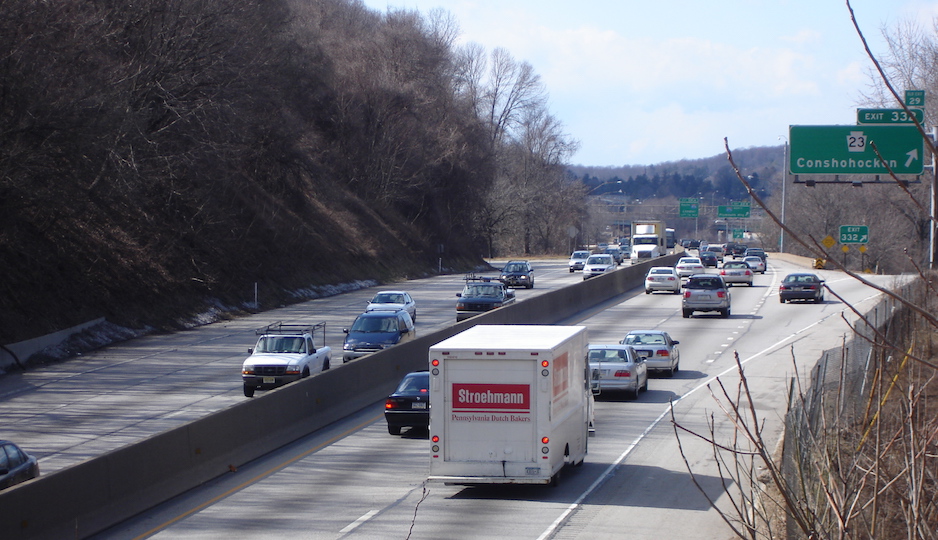PennDOT, SEPTA Team Up to Reduce Schuylkill Expressway Traffic

The Schuylkill Expressway westbound at the Conshohocken exit. | Photo by Krimpet via Wikimedia Commons, used under CC-BY-SA-3.0
PennDOT and SEPTA have teamed up for a multi-modal, $125 million project to reduce traffic along the Schuylkill Expressway, the transportation agencies announced yesterday.
In order to optimize travel time along the 12-mile stretch of I-76 that runs between Philadelphia and King of Prussia, the agencies will tackle multiple means of travel: the expressway, SEPTA’s Manayunk/Norristown Regional Rail line and the Schuylkill River Trail.
“The importance of this corridor to the Philadelphia region cannot be overstated, and it’s imperative that we take advantage of new technologies and partner with SEPTA and other key stakeholders to offer citizens more attractive options for travel between Philadelphia and the northwest suburbs,” PennDOT secretary Leslie Richards said in a statement.
The best part? You’ll eventually be able to drive on the shoulder of the expressway, which will eventually become a “part-time travel lane” when traffic allows. It’s part of what PennDOT called an “active traffic management technology,” which is basically just a fancy phrase for a strategy to reduce congestion and ease travel along the expressway. Construction for that part of the project will begin in five years.
“Part-time shoulder use is currently in place in 16 states across the country, and we plan to implement it on I-76 to help reduce congestion,” Richards said. “Our project team will work closely with the Pennsylvania State Police and local emergency service responders to obtain their input and guidance because driver safety is of paramount importance. We also will communicate with state transportation agencies that currently use shoulders as travel lanes to obtain more insights into their experiences.”
The I-76 ATM plan is derived from a feasibility study of the road, which began in late 2014 and finished up this month. Initial construction is slated to kick off in late 2017.
Per a press release, PennDOT will employ a number of ATMs, including:
• “Ramp Metering: Red and green traffic signals to control the frequency with which vehicles enter the flow of traffic from entrance ramps to increase vehicle throughput during peak hours and increase expressway speeds;
• Junction Control: The use of overhead electronic signs over travel lanes to regulate or close lanes at merge areas to improve traffic flow at high volume interchanges, including U.S. 202/U.S. 422, I-476 and U.S. 1 north and south. It establishes lane priority at interchanges and makes shoulders available for use. This strategy can change based on the relative demand on the mainline and ramps during different hours of the day;
• Dynamic Lane Assignments: Overhead electronic signs provide information for each travel lane on the expressway to identify open lanes and alert drivers of upcoming lane closures due to crashes or disabled vehicles;
• Multi-Modal Enhancements: Utilize various modes of travel (automobile, public transit, bicycle, walking) and take advantage of viable transportation options along the I-76 corridor, including the Schuylkill River Trail and other nearby trails. PennDOT will work to convene a Schuylkill River Trail Master Plan Summit with our partners at the Delaware Valley Regional Planning Commission, Montgomery County, Philadelphia, the Bicycle Coalition, and the local municipalities to identify the needs and priorities of the heavily used trail which is used for both recreation as well as commuting.”
SEPTA will help out by adding additional locomotives and bi-level rail cars to the Manayunk/Norristown Regional Rail line, which the agency hopes will improve customer service and attract more riders.
In addition, PennDOT will “modernize” traffic lights on roads running parallel to the expressway. The signal systems, which will be installed in two to four years, are targeted for Ridge Pike, Route 23, Swedeland Road, Route 320, U.S. 202/DeKalb Pike, South Gulph Road, Henderson Road, Fayette Street, Ridge Avenue, Henry Avenue, Belmont Avenue and U.S. 1/City Avenue.
For more information, check out PennDOT’s website.
Follow @ClaireSasko on Twitter.


